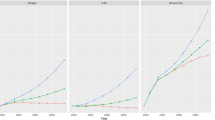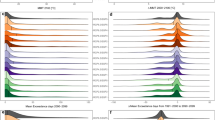Abstract
Several economic assessments of climate change build on the assumption that reductions of cold-related mortality will overcompensate increases in heat-related mortality at least for moderate levels of global warming. Due to the lack of suitable epidemiological studies with sufficient spatial coverage, many of these assessments rely on one particular dataset: projections of temperature-related mortality in 17 countries published almost 20 years ago. Here, we reanalyse this dataset with a focus on cardiovascular mortality and present evidence for two flaws in the original analysis, which would imply a significant bias towards finding net mortality benefits from climate change: (i) the combination of mortality data for all ages with data specific to the elderly and (ii) the confounding of seasonal effects with direct temperature effects on mortality. This bias appears to be further amplified in the integrated assessment models FUND and ENVISAGE, and related economic assessment tools relying on the same calibration scheme, because heat-related cardiovascular mortality is assumed to affect urban populations only in these models. In an exemplary calculation, we show that while FUND currently projects a net reduction of approximately 380,000 deaths from cardiovascular diseases globally per year at 1 °C of global warming, correcting for the two potential flaws and assuming equal vulnerability of urban and rural populations would result in a net increase of cardiovascular mortality, with approximately 150,000 net additional deaths globally per year. Our findings point to the urgent need of renewing damage functions on temperature-related mortality currently applied in some of the most widely used integrated assessment models.





Similar content being viewed by others
References
Ackerman F, Stanton EA (2008) A comment on “Economy-wide estimates of the implications of climate change: human health”. Ecol Econ 66:8–13
Aldy JE, Krupnick AJ, Newell RG, Parry IWH, Pizer WA (2010) Designing climate mitigation policy. J Econ Lit 48:903–934
Barreca A, Clay K, Deschênes O et al (2016) Adapting to climate change: the remarkable decline in the US temperature-mortality relationship over the 20th century. J Polit Econ 124:105–159. doi:10.3386/w18692
Bosello F, Roson R, Tol RSJ (2006) Economy-wide estimates of the implications of climate change: human health. Ecol Econ 58:579–591
Deschênes O (2014) Temperature, human health, and adaptation: a review of the empirical literature. Energy Econ 46:606–619. doi:10.1016/j.eneco.2013.10.013
Deschênes O, Greenstone M (2011) Climate change, mortality, and adaptation: evidence from annual fluctuations in weather in the U.S. Am Econ J Appl Econ 3:152–185. doi:10.1257/app.3.4.152
Ebi KL, Mills D (2013) Winter mortality in a warming climate: a reassessment. Wiley Interdisciplinary Reviews-Climate Change 4:203–212
Gasparrini A (2014) Modeling exposure-lag-response associations with distributed lag non-linear models. Stat Med 33:881–899. doi:10.1002/sim.5963
Gasparrini A, Guo Y, Hashizume M et al (2015a) Mortality risk attributable to high and low ambient temperature: a multi-country study. Lancet 44:16
Gasparrini A, Guo Y, Hashizume M et al (2015b) Temporal variation in heat–mortality associations: a multicountry study. Environ Health Perspect 123:1200–1207. doi:10.1289/ehp.1409070
Green MS, Harari G, Kristal-Boneh E (1994) Excess winter mortality from ischaemic heart disease and stroke during colder and warmer years in Israel. An evaluation and review of the role of environmental temperature. Eur J Pub Health 4:3–11
Greenstone M, Kopitsy E, Wolvertony A (2013) Developing a social cost of carbon for US regulatory analysis: a methodology and interpretation. Rev Environ Econ Policy 7:23–46. doi:10.1093/reep/res015
Guo Y, Gasparrini A, Armstrong B, Li S, Tawatsupa B, Tobias A et al (2014) Global variation in the effects of ambient temperature on mortality: a systematic evaluation. Epidemiology 25:781–789
Guo Y, Li S, Liu DL et al (2016) Projecting future temperature-related mortality in three largest Australian cities. Environ Pollut 208:66–73. doi:10.1016/j.envpol.2015.09.041
Hayashi A, Akimoto K, Sano F, Mori S, Tomoda T (2010) Evaluation of global warming impacts for different levels of stabilization as a step toward determination of the long-term stabilization target. Clim Chang 98:87–112
Honda Y et al (2014) Heat-related mortality risk model for climate change impact projection. Environ Health Prev Med 19:56–63
Houser T, Hsiang S, Kopp R, Larsen K et al (2015) Economic risks of climate change: an American prospectus. Columbia University Press, New York, p 384 ISBN 9780231174565
Hsiang SM (2016) Climate econometrics. Annu Rev Resour Econ:1–33. doi:10.3386/w22181
Huang C, Barnett AG, Wang X, Tong S (2012) The impact of temperature on years of life lost in Brisbane, Australia. Nat Clim Chang 2:265–270. doi:10.1038/nclimate1369
Huang C, Barnett AG, Wang X, Vaneckova P, FitzGerald G, Tong S (2011) Projecting future heat-related mortality under climate change scenarios: a systematic review. Environ Health Perspect 119:1681–1690
Huang C, Chu C, Wang X, Barnett AG (2015) Unusually cold and dry winters increase mortality in Australia. Environ Res 136:1–7. doi:10.1016/j.envres.2014.08.046
IWG (2010) Interagency Working Group on Social Cost of Carbon. Technical support document: social cost of carbon for regulatory impact analysis under Executive Order 12866. February. United States Government.
IWG (2016) Interagency Working Group on Social Cost of Greenhouse Gases. Technical support document: technical update of the social cost of carbon for regulatory impact analysis under Executive Order 12866. August. United States Government
James R, Washington R, Schleussner C-F et al (2017) Characterizing half-a-degree difference: a review of methods for identifying regional climate responses to global warming targets. Wiley Interdiscip Rev Clim Chang e457:1–23. doi: 10.1002/wcc.457
Kalkstein LS, Greene JS (1997) An evaluation of climate/mortality relationships in large US cities and the possible impacts of a climate change. Environ Health Perspect 105:84–93
Kinney PL, Schwartz J, Pascal M, Petkova E, Le Tertre A, Medina S, Vautard R (2015) Winter season mortality: will climate warming bring benefits? Environ Res Lett 10:064016
Lee JY, Kim H (2016) Projection of future temperature-related mortality due to climate and demographic changes. Environ Int 94:489–494. doi:10.1016/j.envint.2016.06.007
Leemans R, Cramer W (1991) Updated as: the CLIMATE database version 2.1. http://www.pik-potsdam.de/~cramer/climate.html. Accessed 15 July 2015
Lomborg B (2007) Cool it: the skeptical environmentalist’s guide to global warming. Knopf Publishing Group, United States
Martens WJM (1998) Climate change, thermal stress and mortality changes. Soc Sci Med 46:331–344
Nordio F, Zanobetti A, Colicino E et al (2015) Changing patterns of the temperature-mortality association by time and location in the US, and implications for climate change. Environ Int 81:80–86. doi:10.1016/j.envint.2015.04.009
Revesz R, Howard P, Arrow K et al (2014) Improve economic models of climate change. Nature 508:173–175
Roson R, van der Mensbrugghe D (2012) Climate change and economic growth: impacts and interactions. Int J Sustain Econ 4:270–285. doi:10.1504/IJSE.2012.047933
Schwartz JD, Lee M, Kinney PL et al (2015) Projections of temperature-attributable premature deaths in 209 U.S. cities using a cluster-based Poisson approach. Environ Health 14:85. doi:10.1186/s12940-015-0071-2
Shi L, Kloog I, Zanobetti A, Liu P, Schwartz JD (2015) Impacts of temperature and its variability on mortality in New England. Nat Clim Chang 5:988–991. doi:10.1038/nclimate2704
Srinivasan UT, Carey SP, Hallstein E, Higgins PAT, Kerr AC, Koteen LE, Smith AB, Watson R, Harte J, Norgaard RB (2007) The debt of nations and the distribution of ecological impacts from human activities. PNAS 105:1768–1773. doi:10.1073/pnas.0709562104
Tobías A, Armstrong B, Gasparrini A (2017) Brief report. Epidemiology 28:72–76. doi:10.1097/EDE.0000000000000567
Tol RSJ (2002a) Estimates of the damage costs of climate change. Part 1: benchmark estimates. Environmental & Resource Economics 21:47–73
Tol RJS (2002b) Estimates of the damage costs of climate change. Part II: dynamic estimates. Environmental & Resource Economics 21:135–160
Tol RSJ (2005) Emission abatement versus development as strategies to reduce vulnerability to climate change: an application of FUND. Environ Dev Econ 10:615–629
Tol RSJ (2009) The economic effects of climate change. J Econ Perspect 23:29–51. doi:10.1257/jep.23.2.29
Tol RSJ (2013) The economic impact of climate change in the 20th and 21st centuries. Clim Chang 117:795–808
UN Population Division (2014) Urban and rural population by age and sex (URPAS). 3rd edition. http://www.un.org/en/development/desa/population/publications/dataset/urban/urbanAndRuralPopulationByAgeAndSex.shtml. Accessed 1 Sept 2015
Vardoulakis S, Dear K, Hajat S, Heaviside C, Eggen B, McMichael AJ (2014) Comparative assessment of the effects of climate change on heat-and cold-related mortality in the United Kingdom and Australia. Environ Health Perspect 122:1285–1292
Watkiss P, Downing TE (2008) The social cost of carbon: valuation estimates and their use in UK policy. The Integrated Assessment Journal 8:85–105
WHO (2014) Quantitative risk assessment of the effects of climate change on selected causes of death, 2030s and 2050s.http://www.who.int/globalchange/publications/quantitative-risk-assessment/en/. Accessed. 19 April 2016
Acknowledgements
The study was undertaken as part of a scientific collaboration between the Potsdam Institute for Climate Impact Research and the Joint Research Center of the European Commission. The views expressed are purely those of the authors and may not in any circumstances be regarded as stating an official position of the European Commission. We thank Simon Gosling and three anonymous referees for very helpful comments on earlier versions of the manuscript.
Author information
Authors and Affiliations
Corresponding author
Electronic supplementary material
Online Resource 1
(PDF 993 kb)
Online Resource 2
(PDF 362 kb)
Rights and permissions
About this article
Cite this article
Huber, V., Ibarreta, D. & Frieler, K. Cold- and heat-related mortality: a cautionary note on current damage functions with net benefits from climate change. Climatic Change 142, 407–418 (2017). https://doi.org/10.1007/s10584-017-1956-6
Received:
Accepted:
Published:
Issue Date:
DOI: https://doi.org/10.1007/s10584-017-1956-6




